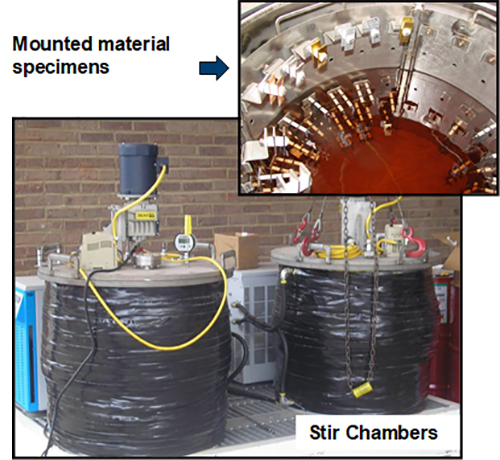| Capability Title | Materials/Component compatibility with advanced fuels |
| Laboratory | Oak Ridge National Laboratory (ORNL) |
| Capability experts | Chris Janke, Mike Kass, Jim Keiser |
| Description | Specialized exposure chambers are coupled with advanced analytical chemistry instruments and methodologies to accurately access fuel-material interactions. Existing test chambers able to expose over 300 polymer, metal and sealant specimens simultaneously under highly controlled conditions of pressure, temperature and flow have been used to represent field conditions for determining fuel compatibility limits for government agencies, Underwriters Laboratories and private industry. Advanced analytical capabilities (which include pyrolysis GC-MS, XDS, and SEM/TEM) have provided valuable insight in the physical & chemical interactions governing compatibility. Additional capabilities include advanced rheological instrumentation to determine fuels efficacy with existing pumps and piping. |
| Limitations | Established capabilities are focused on primarily material interactions. An expensive full system (real-world) analysis (with prototype components) may be required for definitive conclusions. |
| Unique aspects | Exposure chambers can simultaneously exposure over 300 material specimens in both the liquid and vapor phase. The chamber environment can be controlled for pressure, temperature, flow rate, and the chemistry in the head space region. Pyrolysis GC-MS instrument can identify the structural changes that have occurred in polymeric materials following fuel exposure. |
| Availability | All test apparatuses are readily available. |
| Citations/references | 1. Kass, M., Janke, C., Connatser, R., and West, B., “Elastomer Swell Behavior in 1-Propanol, Diisobutylene, Cyclopentanone, and a Furan Mixture Blended in E10 and a Blendstock for Oxygenate Blending (BOB),” SAE Int. J. Fuels Lubr.12(3):2019, doi:10.4271/04-12-03-0011 2. Fioroni, G., Fouts, L., Luecke, J., Vardon, D., Kass, M. et al., “Screening of Potential Biomass-Derived Streams as Fuel Blendstocks for Mixing Controlled Compression Ignition Combustion,” SAE Technical Paper 2019-01-0570, 2019, doi:10.4271/2019-01-0570. 3. Kass, Mike, Chris Janke, Raynella Connatser, Brian West, Jim Szybist, and Scott Sluder, “Influence of biodiesel decomposition chemistry on elastomer compatibility,” Fuel 233(2018), 714-723. 4. Kass, M. and Moriarty, K., “National Labs Examine Effects of New Fuels on Current Equipment,” PEI Journal 12 (2) 2018 pgs. 48-54. 5. Kass, M. and West, B., “Compatibility Assessment of Fuel System Thermoplastics with Bio-Blendstock Fuel Candidates Using Hansen Solubility Analysis,” SAE Int. J. Fuels Lubr. 11(1):43-104, 2018. 6. Kass, M. D., Janke, C. J., Connatser, R.M., Lewis, S. A., Keiser, J. R. and Gaston, K., “Compatibility Assessment of Fuel System Infrastructure Plastics with Bio-oil and Diesel Fuel,” Energy Fuels, 2018, 32 (1), pp 542–553 7. Kass, M. D., Janke, C. J., Connatser, R.M., Lewis, S. A., Keiser, J. R. and Gaston, K., “Compatibility Assessment of Fuel System Elastomers with Bio-oil and Diesel Fuel,” Energy Fuels, 2016, 30 (8), pp 6486-6494. 8. Kass, M., Janke, C., Connatser, R., Lewis, S. et al., “Compatibility Assessment of Elastomeric Infrastructure Materials with Neat Diesel and a Diesel Blend Containing 20 Percent Fast Pyrolysis Bio-oil,” SAE Int. J. Fuels Lubr. 8(1):2015, doi:10.4271/2015-01-0888. 9. Kass, M., Janke, C., Connatser, R., Lewis, S. et al., “Compatibility Assessment of Plastic Infrastructure Materials with Off-Highway Diesel and a Diesel Blend Containing 20 Percent Fast Pyrolysis Bio-Oil,” SAE Int. J. Fuels Lubr. 8(1):2015, doi:10.4271/2015- 01-0893. 10. Kass, M., Janke, C., Theiss, T., Baustian, J. et al., “Compatibility Assessment of Plastic Infrastructure Materials with Test Fuels Representing E10 and iBu16,” SAE Int. J. Fuels Lubr. 8(1):2015, doi:10.4271/2015-01-0894. 11. Kass M. D., Theiss, T. J., Janke C. J., Pawel, S. J., Chapin J. T., Boyce K.., and Yang E., Compatibility of Fueling Infrastructure Materials to Ethanol-blended Gasoline, Sealing Technology December 2012 pgs. 7-12 (Feature Article) |

